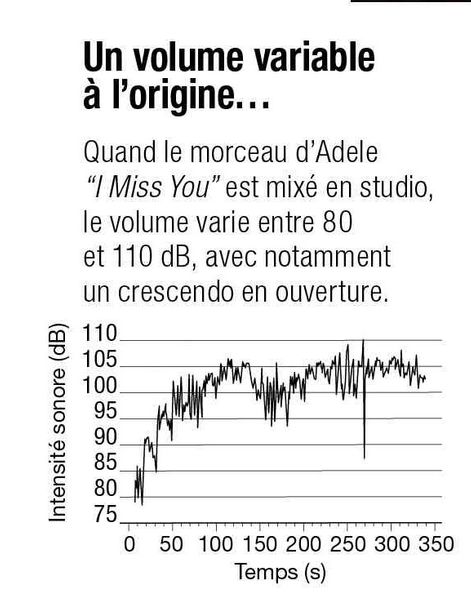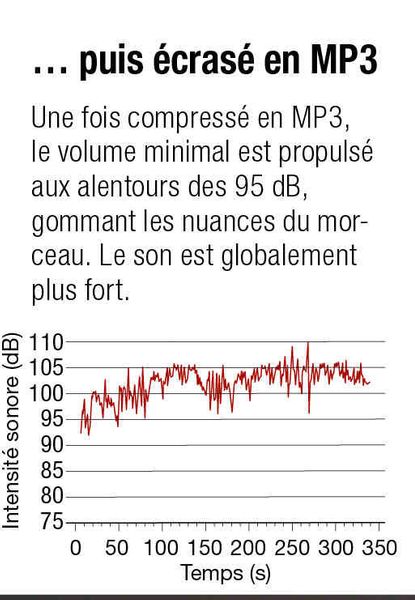We are on February 1, 2022, at the Théâtre du Châtelet. On stage, singer and musician Thomas Dutronic performs. But this party is not a concert like the others. In fact, it is about the conclusion of UNESCO’s “Sound Week”, an annual event that aims to recall the importance of sound in our environment.
During this nineteenth edition, the artist wanted to participate in the effort to prove the potential errors of a particular audio mixing technique: audio dynamics compression. Thomas continued, between compressed and uncompressed performances. For my part, I expected it to be Large screen develops volume to the nearest millisecond, identifies Christian Hugonnet. An audio engineer and audio specialist trained at Arts et Métiers, he founded La Semaine du son in 2003, and for many years has been fighting against a practice that, according to him, only results in shapeless gum. Worse, according to the latest studies by the Pasteur Institute, this compressed sound has serious health consequences! But what is compressed audio again? Let’s go back!
>> Read also: Scientists discover a new type of sound wave
MP3: What is compressed audio?
This phenomenon was born in the 1960s with a very laudable goal: to allow the mixing of two different sources such as guitar and drum. “All low volume levels are electronically reduced to powerful levels. For a cooking analogy, it’s a bit like turning a souffle into a galette plate“And the Christian Huguenet explains. An interesting finding in the case of music with high dynamic ranges, such as Bolero by Ravel. In this ballet, we sometimes strain our ears, with passages of up to 40 decibels, and then be amazed by the flights of 100 decibels. The pressure makes it possible to crush this chain of escalation and decrement that is hard to listen to at home…moreover, if you have neighbours!
But compression has another, much stronger advantage: it allows sound to easily override ambient noise. The opportunity is very good for television advertising, which seized this mixing technique in the 90s. By balancing the sound to the maximum volume chosen, the ads suddenly give the impression that they are more noisy than other programmes.
Soon the idea spread to all audio-visual media … Prompted by the success of MP3 players, audio compression swept us over radio, telephone, video games, television and the network … Problem: compressed, sound loses quality. Indeed, the pressure squashes the nuances available to the ear. A serious danger to the performing professions: due to the lack of awareness of natural sounds, musicians lose their ability to play on variations. Christian Huguenet adds, “Actors are also affected, because the art of oral expression as practiced in theater amounts to a difference of tone.” The sound pressure also flattens the signal in such a way that the partial silence, these natural breaths of the ear, disappears. All sounds, even the weakest ones, are amplified, normalized, sound energy accumulates and the result sounds louder when listening, without necessarily being louder.
>> Read also: What is the maximum possible noise?
102 dB
This is the maximum volume allowed in a discotheque in France since 2017. For safe listening: 80 dB is recommended. Acute pain in the ears appears at 120 decibels.
523.9 million
As of mid-2021, approximately 524 million people worldwide are registered to one of the various streaming platforms available. This is a 26.4% increase over the previous year.
4.5 million
This is the number of vinyl records sold in France in 2020. While CD sales are declining, vinyl is experiencing a second boom with a 10% increase in sales compared to 2019. A side effect of confinement.
Example of a nightclub: the most toxic case for hearing?
” You don’t have to research further to understand why we tend to talk too loudly on the phone. We take the fold of the compact world ”, Christian Huguenet worries. And now, sixty years after its invention, and while it is everywhere, the compressed sound reveals other consequences, not the least … it will have a detrimental effect on health! This was suggested by a study by the team of Paul Avane, a biophysicist and current director of the Ceriah (Center for Research and Innovation in Human Audiology) at the Pasteur Institute.
To arrive at this late discovery, the researcher imagined an amazing experiment. “With my team from the University of Clermont-Auvergne, we sought to deal with the discotheque condition, which seemed to us probably the most toxic. So our experiments did not exceed 102 decibels, the regulatory limit over a period of about four hours and Describe the biophysicist.
Scientists have deliberately gone for a high level of noise, believing that no physiological effects should appear – the threshold imposed by law is supposed to prevent it! With zero risk, however, the team avoided human volunteers to turn into other guinea pigs. We needed animals that could be tamed He can handle it without having to put her to sleep.” Paul Avan remembers. The furry role of a guinea pig or guinea pig (Caffeine purcellus). Calm by nature, this animal hears in the same frequency ranges as humans, unlike mice or mice, for which it was necessary to compose certain music! “We compared a bunch of snippets of all kinds of music: classic, rock, pop, electro… our choice finally fell on Adele’s song, I miss you,” says the biophysicist. Highly modified music – with many silences around 100 milliseconds – and stretched in frequency.
Once the sample was calibrated to last for exactly five minutes, the sample was ready to tirelessly repeat for four hours, or 48 listens! Some guinea pigs were able to benefit from the “natural” version, others from the compressed version. But how can the potential hearing loss of these people be measured? In humans, a tonal acoustic scheme is performed using headphones through which sounds (high to low) of different intensities and frequencies pass. The person being tested should raise their hand when they hear a sound. It is difficult to breed with guinea pigs … “There are other methods such as otoemission, which consists of capturing re-emitted sounds from the inner ear to infer their sensitivity. It is a method known because used in all newborn examinations”, Paul Avan reassures.
“
We must fight the ignorance of the French on this fundamental issue of our healthy environment. – CHRISTIAN HUGONNET, sound engineer and founding president of Sound Week
“
Caution priority
The scientists also measured contractions of the middle ear muscles to assess the brain’s protective responses, thus stressing neurons. After 24 months of testing and 90 male guinea pigs who became fans even though they were British singers, the results came out. Relief: No trace of damage to the inner ear due to sound pressure was observed. But here is one point in particular that worries researchers. On average, in guinea pigs that listened to the compressed sound, their protective reactions were reduced by more than 50%, and that’s for about a week! “Imagine you’re talking about body aches. If you’ve had it for a few days, you’re fine. But if it lasts for seven days, it’s time to go to the doctor,” Explains a biophysicist.
RESULTS: Individuals with impaired reflexes find themselves dangerously exposed to a loud sound during the week following listening. And there is no way to reassure themselves by giving them quarter-hour breaks from time to time, because the beneficial effect is minimal. Exposure to compressed sound for a period of time can cause significant auditory stress, and its long-term effects are still poorly understood. The discovery of the mechanisms remains in the works. “Our hypothesis is that Waste products accumulate due to intense metabolic work during the audit due to the lack of exact silence. Future work will explore this idea.Paul Avan announces. In the meantime, even if these results remain to be observed in humans, the priority is caution. “Pair your TV with a set of remote video conferencing, and you’ll leave people with thin minds unable to make an informed decision,” Christian Huguenet protests. Especially since the solution is simple: dispense with the pressure of sound dynamics and return to the sound of the past year, natural and harmless. “With advances since the 1960s, particularly in noise reduction systems, it has become easier to erase ambient noise without using pressure,” Little Paul Avan.
>> Read also: The Brain: What Happens When Hearing Becomes Listener?
Audio mix, from studio to headphones
originally variable size…
When the path of Adele “I miss you” In the studio, the volume is between 80 and 110 decibels, with it particularly ramping up when open.
… then write to MP3
Once compressed in MP3 format, the minimum volume level is pushed down to around 95dB, erasing the nuances of the song. The sound is generally louder.
One advertising skill
Have you ever had the unpleasant impression in front of your TV of an explosion of sound during an advertisement? Well, it’s not just an impression… Since the 1990s, advertisers have been manipulating audio dynamics compression in order to broadcast their messages above the ambient noise, without exceeding the maximum volume required by law. Instead of decibels, it is the inner ear contact that gives a false sense of volume increase. “So the ad volume stays at its maximum all the time,” says Christian Huguenet, sound engineer. The idea hit the target, and in order for their niche to exist, all the advertisers followed suit.
Towards a sound quality label based on scientific standards!
At the risk of slowly but surely changing our listening, change is sorely needed, the researchers suggest! “We must combat the lack of knowledge of the French in this basic subject, which is our healthy environment, and realize the importance of listening for communication and socializing”, Christian Hugonnet alert.
Will we wait to lose the natural sound to appreciate it at its fair value? Accompanied by Universal France and Ircam, the sound engineer chose to act: “We are in the process of creating a sound quality label project, based on scientific standards, which will be available from 2023.”
By striving to reduce risks to human health, this work should also improve the quality of the recordings, which are richer in acoustic variations. And perhaps it encourages us to re-appreciate the silence in our world, which is already cacophonic enough without pressure.

“Subtly charming problem solver. Extreme tv enthusiast. Web scholar. Evil beer expert. Music nerd. Food junkie.”






